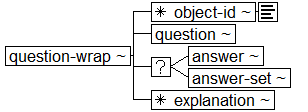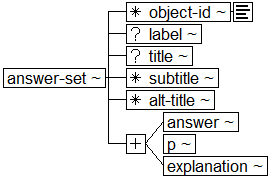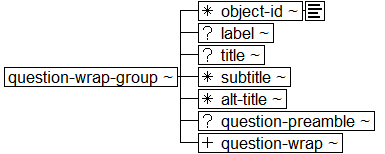◇◆
Questions and Answers
The Question/Answer models define XML structures
for questions
and answers that may be used, for example, to tag a back-of-the-chapter quiz. By design,
these elements do not constitute the full model for a quiz, test, exam, etc.; the
intent is that such a model
could be built using these Question/Answer components. The result is a basic model
that allows for
a simple question followed by its corresponding answer but also for more complex cases,
such as a multiple-choice question that provides several options, possibly along with
the correct answer and an explanation of that answer.
Where Question/Answer Elements can be Used
The Question/Answer structures were taken from BITS (the JATS book tag set). Since
BITS is a loose Tag Set that restricts very little and allows structures
in a wide variety of places, the elements <question-wrap>, <question>, <answer-set>, <answer>, and <explanation> can be used in
many places, for example, inside <sec>, inside <body>, or inside <boxed-text>.
Question/Answer Semantic Attributes
The Question/Answer elements were given the ubiquitous JATS attributes @specific-use, @xml:base, and @xml:lang.
In addition, the Question/Answer models were given a set of semantic attributes:
|
audience
|
Defined only on the top-level wrapper elements (<question-wrap> and <question-wrap-group>) to name the perspective audience for the question(s). The text value of this attribute
contains a very short description of the intended audience, for example, “patients”, “dermatology-students”.
|
|---|---|
|
correct
|
Marking <option> elements as correct (yes) or not (no).
|
|
pointer-to-explained
|
Used on an <explanation> element to point to the question,
answer, or option that is being explained. (If an <explanation> should be associated with several components, such as a <question>, several options, or an <answer>, the @id of each should appear in the @pointer-to-explained attribute, separated by spaces.)
|
|
pointer-to-question
|
Used on an <answer> element to point to the question
it correctly answers. (If an <answer> should be associated with several questions (<question>), the @id of each should appear in the @pointer-to-question attribute, separated by spaces.)
|
|
question-response-type
|
Allowed on the <question> element to describe the type of answer(s)/response(s) expected for the question.
The values for this attribute come from a restricted list:
|
Overview of Question/Answer Structures
The elements that comprise Questions/Answers are described in the individual elements
in this Tag
Library, but, for convenience,
this material has been summarized below for the elements:
Question Wrappers
The top-level element wrapper <question-wrap> holds one question, its optional answer(s), as well as any explanation(s). The wrapper
may be assigned DOIs or other identifiers.
Each <question-wrap> may contain (in order):

- Optionally, one or more identifiers, such as DOIs at the beginning (<object-id>);
- One required <question>;
- Optionally, one <answer> or one <answer-set> (which could contain multiple answers); and
- As many <explanation> elements as necessary.

This wrapping is optional, and questions, answers, and explanations can be used in
other contexts. The intent is to provide a way to capture question and answer
material, wherever it appears in narrative text or tables.
Here are two simple questions (wrapped with their answers inside <question-wrap>):
... <question-wrap> <question id="q3" question-response-type="short-answer"> <p>How many moons does Mars have?</p> <p>(Name them for extra credit)</p> </question> <answer pointer-to-question="q3"> <p>Two: Phobos and Deimos</p> </answer> </question-wrap> <question-wrap> <question id="q4" question-response-type="essay"> <p>From the point of view of England, what were the underlying causes of World War II?</p> </question> <answer pointer-to-question="q4"> <p>Answer must be no longer than 2500 words.</p> </answer> </question-wrap> ...
Questions, Answers, Options, and Explanations
The interior structure of a question, answer, option, or explanation can be very complex,
mimicking the complexity
of a section, but each of these structures can also be described with a single, typically
labeled, paragraph. The interior structure is very fluid and enabling, and not at
all directive or enforcing.
Questions
A <question> element contains the request for an answer, typically used in
the text for review or as part of a quiz, exam, etc. A question may ask a direct question,
but it may also make a statement that the student is to discuss in an essay or to
mark as true or false.
Each <question> may contain:
- Optionally, one or more identifiers, such as DOIs at the beginning (<object-id>); and
- The same things that can be inside a section (including section-level metadata, a label, a title, subtitles, and alternate titles followed by paragraph-level objects or embedded sections, or both).
Everything inside a <question> is optional; so a question can
contain either a paragraph or a fully labeled section with interior subsections. A
question
typically takes an @id attribute, so that answers and explanations
can be associated with it.
Answers
An <answer> element contains a correct response to a question. Each <answer> may contain:
- Optionally, one or more identifiers, such as DOIs at the beginning (<object-id>);
- Optionally, a label, a title, subtitles, and alternate titles;
- Followed by either sections or paragraph-level objects followed by sections;
- Followed by the same back matter as sections allow; and
- Followed by as many explanations (<explanation>) as needed.
Not everything inside an <answer> is optional; an answer must contain either some paragraph-level or some
section-level text. An answer must be associated with at least one question with a
@pointer-to-question attribute.
Options to a Question
An <option> element contains one of the possible answer choices for a multiple-choice question.
Each <option> may contain:
- Optionally, one or more identifiers, such as DOIs at the beginning (<object-id>);
- Optionally, a label, a title, subtitles, and alternate titles;
- Followed by either sections or paragraph-level objects followed by sections;
- Followed by the same back matter as sections allow; and
- Followed by as many explanations (<explanation>) as needed.
Not everything inside an <option> is optional; an option must contain either some paragraph-level or some section-level
text.
Here is a multiple-choice question with three options, one of which is correct:
...
<sec id="sec45">
...
<question-wrap>
<question id="q1" question-response-type="multiple-choice">
<label>1</label>
<p>Where was the first permanent English
settlement in the New World?</p>
<option correct="no">
<label>A</label>
<p>Plymouth</p>
</option>
<option correct="yes" id="q1b">
<label>B</label>
<p>Jamestown</p>
</option>
<option correct="no">
<label>C</label>
<p>Roanoke</p>
</option>
</question>
<explanation pointer-to-explained="q1b">
<p>Established by the Virginia Company of London, Jamestown
was the first permanent English settlement in the New World;
it flourished from 1607 to 1699. Although the Roanoke colony
was founded earlier (in 1587), that colony failed; upon returning
from a trip to England for supplies, its Governor found the
settlement abandoned. Although one of the earliest New England
colonies, Plymouth (in modern Massachusetts) was not founded
by the Pilgrims until 1620.</p>
</explanation>
</question-wrap>
</sec>
...Answer Set
An <answer-set> element contains a group of answers, for example, answers to a multi-part question.
Each <answer-set> may contain:

- Optionally, one or more identifiers, such as DOIs at the beginning (<object-id>);
- Optionally, a label, a title, subtitles, and alternate titles;
- A choice of as many answers (<answer>) as necessary, interspersed with paragraphs (<p>) and explanations (<explanation>) elements as needed.

Here is a moderately complex answer set, in which the third question has three <answer>s nested inside an <answer-set>:
...
<sec id="sec45">
<title>The Answers</title>
<p>Students should use the answers below to check
their understanding.</p>
<answer-set>
<answer pointer-to-question="q1">
<p>B</p>
</answer>
<answer pointer-to-question="q2" id="ans2">
<p>false</p>
<explanation pointer-to-explained="ans2">
<p>Soviet cosmonaut Georgy Beregovoy was born three months
and three days earlier than United States astronaut John
Glenn, whose birth date is July 18, 1921.</p>
</explanation>
</answer>
<answer pointer-to-question="q3">
<answer-set>
<answer pointer-to-question="q3a" id="ans3a">
<p>1</p>
</answer>
<answer pointer-to-question="q3b" id="ans3b">
<p>3</p>
</answer>
<answer pointer-to-question="q3c" id="ans3c">
<p>2</p>
</answer>
<explanation pointer-to-explained="ans3a ans3b ans3c">
<p>Glenn resigned from NASA on January 16, 1964. He
won election to the United States Senate in 1974. On
October 29, 1998, he became the oldest person to fly
in space.</p>
</explanation>
</answer-set>
</answer>
<answer pointer-to-question="q4">
<p>This selection is a biographical sketch of John Glenn's
career. The sketch focuses upon his achievements at NASA,
notably his becoming the first American to orbit the Earth
in 1962. The biography also discusses his retirement from
the Marine Corps and subsequent election to the United
States Senate, where he continued his interest in space
flight. The bio concludes with his participating at age 77
in a Space Shuttle mission.</p>
</answer>
</answer-set>
</sec>
...Explanation
Explanations provide information about a question and the options or answer(s) to
that question. An @rid on the <explanation> points to the questions, option, or answer with which it is associated. Since an
<explanation> might provide information relevant to many questions and/or answers, <explanation> may have multiple @rid values.
Each question (inside a <question-wrap>), each <answer> or <answer-set>, or <option> may take one or more explanations. In addition, explanations may float freely in
text, so an entire section can be composed of explanations.
Each <explanation> contains at least one or more paragraphs of text that provide a description of a
Question/Answer, answer, option, or answer set. The <explanation> may describe, for example, why this
particular option is incorrect, or where in
the text the material to answer this question
can be found, how to differentiate this answer from similar answers, etc. Explanation
descriptions may be as long and complicated as sections.
Note the <explanation> in the example below:
...
<sec id="sec45">
...
<question-wrap>
<question id="q1" question-response-type="multiple-choice">
<label>1</label>
<p>Where was the first permanent English
settlement in the New World?</p>
<option correct="no">
<label>A</label>
<p>Plymouth</p>
</option>
<option correct="yes" id="q1b">
<label>B</label>
<p>Jamestown</p>
</option>
<option correct="no">
<label>C</label>
<p>Roanoke</p>
</option>
</question>
<explanation pointer-to-explained="q1b">
<p>Established by the Virginia Company of London, Jamestown
was the first permanent English settlement in the New World;
it flourished from 1607 to 1699. Although the Roanoke colony
was founded earlier (in 1587), that colony failed; upon returning
from a trip to England for supplies, its Governor found the
settlement abandoned. Although one of the earliest New England
colonies, Plymouth (in modern Massachusetts) was not founded
by the Pilgrims until 1620.</p>
</explanation>
</question-wrap>
</sec>
...An explanation must be associated (using a @pointer-to-explained attribute) with one or more objects that it explains.
Question Wrapper Groups
Question Wrap Groups (<question-wrap-group>) contain a series of related questions. For example, a series of questions may be
related because they all share the same setup/preamble information such as instructions
on how to approach the questions or record the answers and material that is relevant
to more than one question. The <question-wrap-group> element contains such setup/preamble information (the diagram, picture, graph, story,
or similar) followed by several questions concerning that setup (each question tagged
as a <question-wrap>). For example, a diagram of a triangle with several parts labeled may be shared by
questions such as “What is angle 'a'?”, or “Given only the information in the diagram,
can you calculate the length of the line from 'b' to 'd'?”
Each <question-wrap-group> may contain:

- Optionally, one or more identifiers, such as DOIs at the beginning (<object-id>);
- An optional <label>;
- Optional title information (title, subtitle, alternate title);
- An optional <question-preamble>; and
- As many <question-wrap> elements as necessary.

Here is an example of a <question-wrap-group> with a preamble and two questions, each in its own <question-wrap>:
...
<question-wrap-group>
<question-preamble>
<p>Directions: Read the selection. Use the selection to answer
questions 1 — 4.</p>
<disp-quote>
<p>John Herschel Glenn, Jr. (born July 18, 1921) is a former
U.S. Marine Corps aviator, engineer, astronaut and United States
senator. He was ...</p>
...
</disp-quote>
</question-preamble>
<question-wrap>
<question id="q1" question-response-type="multiple-choice">
<label>1</label>
<p>In the selection, what does the word concussion mean?</p>
<option correct="no"><label>A</label>
<p>Judgement or decision reached by reasoning</p></option>
<option correct="yes"><label>B</label>
<p>Injury caused by a blow to the head</p></option>
<option correct="no"><label>C</label>
<p>Broken elbow</p></option>
</question>
</question-wrap>
<question-wrap>
<question id="q2" question-response-type="true-false">
<label>2</label>
<p>John Glenn was older than Georgy Beregovoy.</p>
</question>
<answer pointer-to-question="q2" id="ans2">
<p>false</p></answer>
</question-wrap>
...
</question-wrap-group>
...